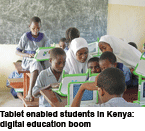Until recently Grace Wambui, a 14-year-old pupil in Nairobi, had never touched a tablet computer. But it took her about “one minute”, she says, to work out how to use one when such devices arrived at her school, a tin shack in Kawangware, a slum in the Kenyan capital.
Other students at the Amaf School were no slower to embrace the new tool. Teaching used to be conducted with a blackboard and a handful of tattered textbooks. Now children in groups of five take turns to swipe the touch screen of the devices, which are loaded with a multimedia version of Kenya’s syllabus.
The tablets at Amaf School are an exception; they are part of a pilot project run by eLimu, a technology start-up. But if it and other firms are right, tablets and other digital devices may soon be the rule in African schools, many are betting on a boom in digital education in Kenya and elsewhere. Some executives even expect it to take off like M-Pesa, Kenya’s hugely successful mobile-money service.
 Such growth in digital education would be timely. The number of children in Africa without school places may have dropped in recent years, but a flood of new pupils has overwhelmed state schools, which are already underfunded and poorly managed. “Business as usual is not working,” says Mike Trucano, an education and technology expert at the World Bank.
Such growth in digital education would be timely. The number of children in Africa without school places may have dropped in recent years, but a flood of new pupils has overwhelmed state schools, which are already underfunded and poorly managed. “Business as usual is not working,” says Mike Trucano, an education and technology expert at the World Bank.
A for-profit venture, eLimu (“education” in Swahili) is one of several local publishers looking to disrupt the business of traditional textbook vendors, who are often slow and expensive. It aims to show that digital content can be cheaper and better. Safaricom, the Kenyan mobile operator which pioneered the M-Pesa service, hopes to repeat its success in digital education. It is developing classroom content, from videotaped lessons to learning applications, that any of Kenya’s 7,000 state secondary schools will be able to access online.
The prospect of many of Africa’s 300 million pupils learning digitally has not escaped the attention of global technology giants either. Amazon has seen sales of its Kindle e-readers in Africa increase tenfold in the past year. The firm’s developers are adding features to its devices with the African consumer in mind: talking books, new languages and a longer battery life. Intel, a chipmaker, hopes education will generate much of the double-digit growth it expects in Africa.
Such success is proof that even the poor are willing to pay for digital education — as they already do for the conven-tional kind. In Kenya, eight out of ten parents pay tuition for courses outside school. Amaf School charges about $10 a month. Start-ups such as eLimu hope to make money with micro-payments, very small sums paid per download.
A bigger question is whether digital tools will actually improve education. Early results are encouraging. In Ghana, reading skills improved measurably among 350 children who had been given Kindle e-readers by Worldreader, a charity. In Ethiopia, researchers found that even in the absence of teachers, children figured out how to use tablets provided to them by One Laptop Per Child, another charity, to teach themselves to read.
At Amaf School, average marks in science, for instance, went from 58 to 73 out of 100 in a single term, says Peter Lalo Outa, the headmaster. That is good news for eLimu. “We want to prove that learning outcomes are improved,” says Nivi Mukherjee, the firm’s boss, “and not use technology for technology’s sake”.
(Excerpted and adapted from The Economist)



























